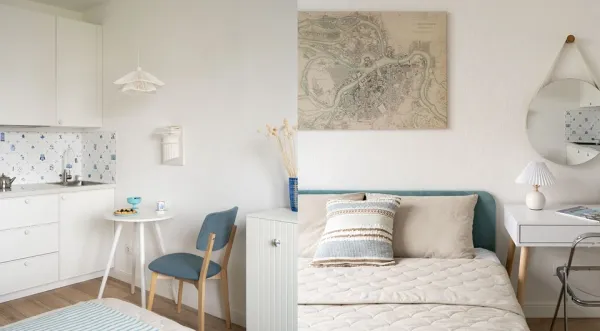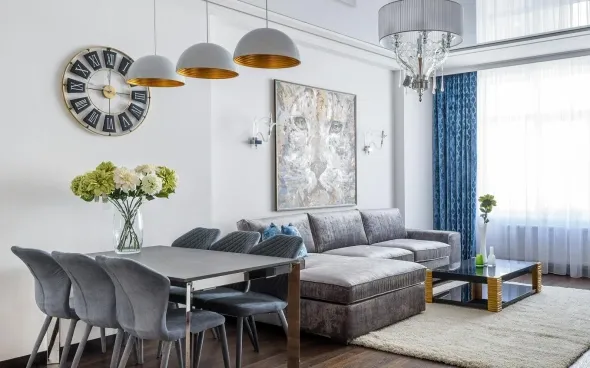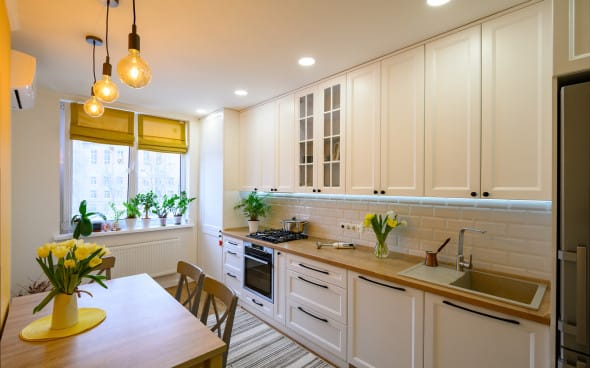Lesson 14: How to Highlight and Design a TV Area in Your Living Room - 7 Ideas
The TV area isn't just for watching shows; it's a key feature of your living room's design. In this lesson, we break down 7 stylish ways to place, highlight, and decorate your TV zone.

The TV area is one of the core functional zones in any living room, a space where comfort meets daily entertainment, and where families often gather to relax together.
In some interiors, the TV becomes the central design accent, supported by bold furniture and eye-catching decor. In others, it's subtly integrated into the overall style, sometimes hidden in a niche or blended into the wall.
No matter the approach, one thing remains essential: the TV area must be functional, well-placed, and thoughtfully lit. Let's explore tips on how to position, highlight, and decorate a TV area to suit a variety of interior styles.
Basic Rules for TV Zone Design
At the heart of any well-planned TV area are three key elements: proper screen height, the right viewing distance, and good lighting that avoids glare.
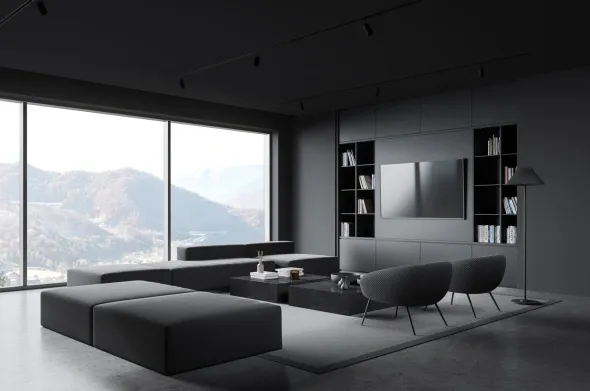
The ideal setup looks like this:
- TV height from the floor: about 120cm (47 in), so that your eye level is perpendicular to the center of the screen when seated.
- Distance from seating: use this formula - TV diagonal x3 or 5. For example, a 55" screen should be around 2.5-3.5 meters away from the sofa.
- Lighting: never place the TV directly opposite windows or strong light sources. This reduces glare and improves viewing comfort.
I advise using soft lighting or track systems instead of bright ceiling lights. Add table lamps or wall scones for cozy ambient light. This reduces eye strain when watching TV in dim rooms.
TV Area Design Ideas for Different Styles
Whether your TV should be a bold statement or quietly fade into the background depends on your room's layout, style, and overall design concept. But in every case, the goal is a balance between beauty and practicality.
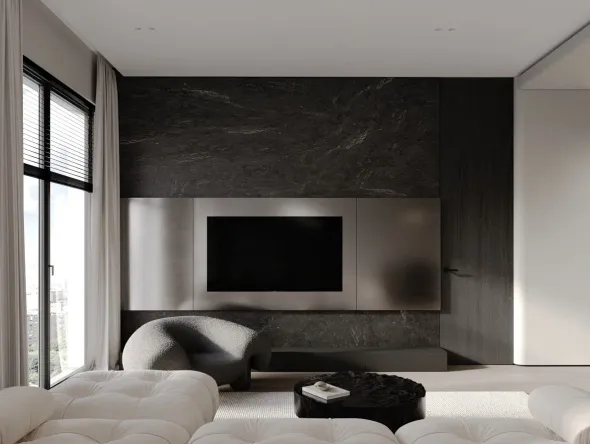
Here's how to approach TV zone across different styles:
1. Modern Minimalist Living Room
This style is one of the most promising directions in current interiors. Minimalism reflects the rising demand for calm luxury. A TV area in this style uses smooth beige furniture and light-colored walls, creating a visual effect where the screen appears to float. The result: a spacious, airy atmosphere free of distractions.
2. Loft-Style Living Room
The loft thrives in open, expansive layouts - high ceilings, large windows, exposed beams, and minimal inner walls. Mount the TV on a statement wall to save floor space. Position a generous sofa or cozy armchairs across from it, and combine overhead, floor, and table lighting to build warmth and texture.
3. Classic Living Room
In a modern classic setting, the TV is paired with refined furniture and timeless accents, like a decorative fireplace. This style blends elegance with comfort, creating a space that feels both luxurious and welcoming. Its ideal for daily life and entertaining.
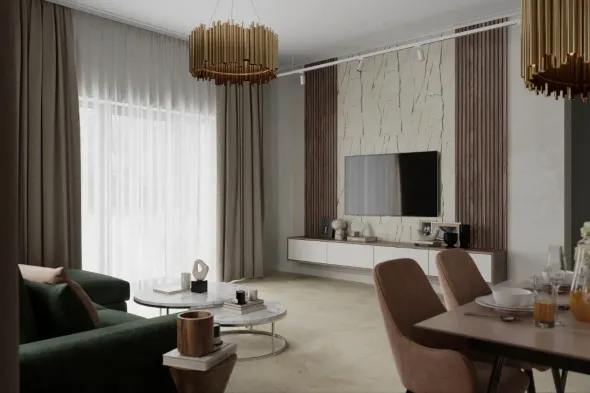
How to Highlight the TV Zone
You can make your TV area stand out without compromising function. Here are several creative approaches:
4. Large Format Wall Panels
Materials like marble-look porcelain slabs create a dramatic yet cohesive backdrop for the TV. This treatment reduces the contrast between the wall and screen, adds depth, and feels elevated while being durable and low-maintenance.
5. Textured Wood Wall Panels
Ribbed or grooved wood panels are both on-trend and multifunctional. They soften the mood, improve acoustics, and give the room an inviting, refined atmosphere.
6. TV and Fireplace Combo
Pairing a biofireplace with the TV turns your wall into a design focal point. This layout merges warmth and entertainment in one elegant feature while also visually dividing open-concept spaces.

How to Decorate the TV Area
Start by defining your overall interior style. Then focus on functionality will the TV be wall-mounted, placed on a console, or hidden in a custom niche?

Key design tips:
- Choose modular storage systems: This allows you to build your perfect combination of shelves and cabinets.
- Plan for hidden storage: make space for remotes, consoles, and accessories using drawers or cabinets with solid doors.
- Select a cohesive color palette: Stick to soft, muted tones for furniture and walls to avoid clashing with the screen. Try a monochrome base (white, beige, grey, or black) with subtle metallics or colorful accents.
- Conceal the wires: use built-in cable channels or decorative covers to keep cords out of sight.
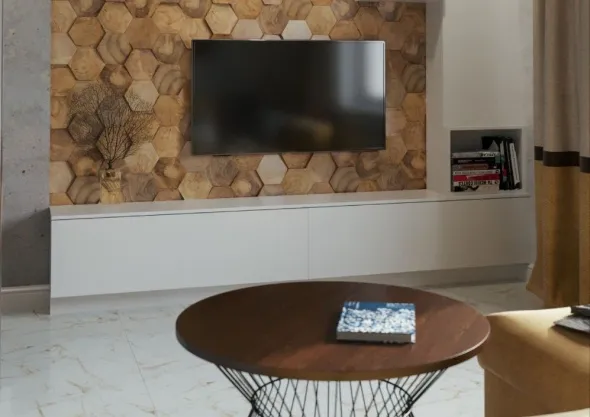
My Answers to Common Questions
What are the most common TV zone mistakes?
- Oversized wall units: Old-school wall units often overwhelm the space. I solved this in one project by replacing a bulky setup with a sleek modular system. It made the room feel lighter and larger.
- Mounting the TV too high: This causes discomfort. your eyes shouldnt strain to look up, the screen should be aligned with your seated eye level.
- Placing the TV near heat or humidity: TVs above fireplaces or close to radiators need extra protection. Use proper materials and plan ahead to ensure safety and durability.
How do I choose the right TV height and distance?
Mount the TV about 110-120 cm from the floor to the center of the screen. Keep the TV away from direct light and windows. Use the formula: screen diagonal x 3-4 for optimal viewing distance. For example, a 55" screen = 2,5 - 3,5 meters from the seating area.
Enjoyed this lesson? There's more waiting.
Support Aesthete to unlock the full archive of architecture and interior style lessons - including tomorrow's post on Avant-garde interiors, plus 70+ exclusive deep dives, style guides, and subscriber bonuses.
For just 3.99/month, you'll get:
- Access to all premium lessons
- A downloadable Style Index PDF (coming soon!)
- Exclusive moodboards and design tips
Become a Supporter Now - help keep thoughtful design content independent.

